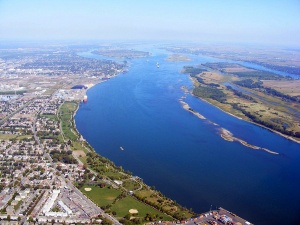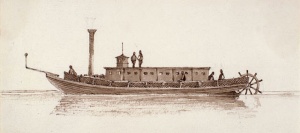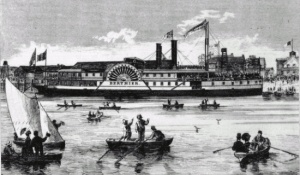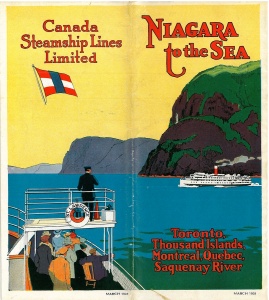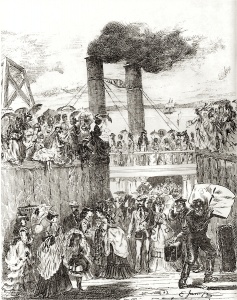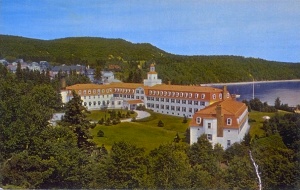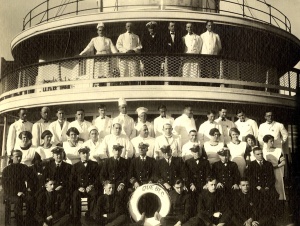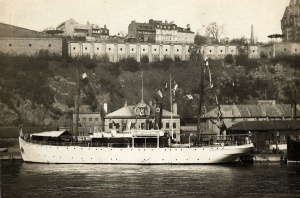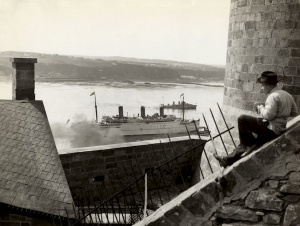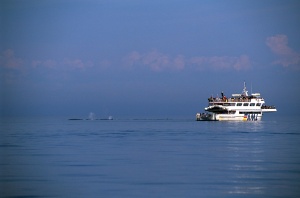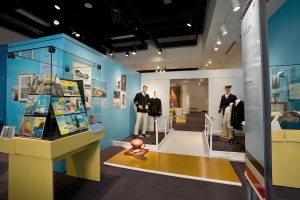Cruises on the Saint Lawrence River
par Couvrette, Sébastien
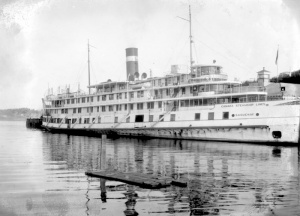
The Saint Lawrence River cruise industry has a long and rich history going back to the beginning of the nineteenth century. Intense competition among groups of Quebec businessmen gave rise to a passenger transportation empire, culminating in the formation of the Canada Steamship Lines in 1913. This company operated the famous "white boats" cruise circuit, which was active from the 1840s until the 1960s, and the luxury hotels built for its wealthy clientele. At the turn of the twentieth century, these cruises and hotels, and the resort areas in which they were located, were known throughout North America. Today, this industry is turning to the clientele of international cruises, making the Saint Lawrence River ports essential ports of call.
Article disponible en français : Croisières sur le fleuve Saint-Laurent
A developing sector
Since 2010, the Croisières AML company has been providing its passengers an unforgettable historical experience by reviving the era of the "white boats", impressive cruise ships that plied the waters of the Saint Lawrence from the mid-nineteenth century until the 1960s. This initiative by the cruise company is part of the growing industry's effort to diversify its activities by offering short local or thematic cruises - tours of cities as seen from the water, whale-watching excursions, visits to historical sites - and to attract international clients.
To encourage the development of international cruises on the Saint Lawrence, the governments of Quebec and of Canada in 2008 launched large-scale programs to encourage the building of tourist infrastructure downstream of Quebec City (NOTE 1). These programs provide financial support to municipalities and to local stakeholders for developing strategies to enhance their local heritage, as an attraction to tourists. At present, the ports of Quebec City and Montreal play a double role both as final destinations and as ports of call on the Saint Lawrence, and there are now seven other ports of call: Trois-Rivières, Saguenay, Baie-Comeau, Sept-Îles, Havre-Saint-Pierre, Gaspé, and the Îles de la Madeleine. These cruises have from the beginning facilitated contact with the incomparable landscapes of the majestic Saint Lawrence River, as well as its wildlife and the human heritage on its shores.
The birth of an industry
The origin of the Saint Lawrence cruise industry goes back to the beginning of the nineteenth century. The first steamboat on the river was the Accommodation, the property of the Montreal businessman John Molson, which in 1809 began to transport passengers regularly between Montreal and Quebec City. In the following decade, many well-off urban travellers embarked on Molson's steamships, fleeing the city to enjoy the quieter regions of Kamouraska, Charlevoix and Saguenay. This phase of the Quebec tourist industry is called tourisme de distinction (elite tourism).
To meet the increasing demand, John Molson increased his fleet, and in 1822 founded the very first steamboat company in Quebec, the St. Lawrence Steamboat Company. In the early 1830s, their ship Waterloo travelled regularly between Quebec City and La Malbaie. The company later signed agreements with the Torrance family, owners of maritime transport companies on the Saint Lawrence, concerning services offered and prices charged, in order to reduce competition between them and to optimize profits in their businesses. A few years later, the Molsons acquired a monopoly on steam navigation on the Ottawa River, which gave them control over the region west of Montreal. However, the success of this flourishing industry gave rise to vigorous competition.
In 1845 a group of mostly French-speaking businessmen from the Richelieu Valley set up a navigation company that was to become the Compagnie du Richelieu (NOTE 2). This new enterprise towed boats and transported passengers and freight on the Richelieu River, which since the 1820s had been a busy maritime route for the export of wood to the United States. In the mid-nineteenth century, as railroads were growing and water-borne transport on the Richelieu was declining, the company extended its activities to the Saint Lawrence River. It was thus in competition with the steamboat lines led by the English-speaking businessmen John Molson and David Torrance.
Building an empire
Beginning in the 1850s, led by the shipbuilder Jacques-Félix Sincennes who became its director, the Compagnie du Richelieu concentrated more and more on a strategy of mergers to increase profits by absorbing its competitors and increasing its dominance over the cruise industry and transport on the Saint Lawrence. In 1856 it put into service two ships, the Victoria and the Napoléon, on the popular Montreal-Quebec City line, where large companies were already competing. The next year it amalgamated with the Torrance Line and became a leading player, competing with the Molson family. In 1875 it joined with the Canadian Navigation Company, owned by the shipping magnate Hugh Allan, which transported passengers on the Upper Saint Lawrence. The resulting company was called the Richelieu and Ontario Ships Line. A few years later, in 1886, it acquired the popular Saguenay River circuit served by the Molsons (NOTE 3). There were then eighteen ships plying the waters of the Saint Lawrence under the company's flag (NOTE 4). Finally in 1913 the Richelieu and Ontario Ships line merged with other companies to form the Canada Steamship Lines.
Majestic ships and luxury hotels
In the second half of the nineteenth century, villégiature (vacation) - the term refers to a time of leisure or rest in the country, particularly in summer, spent in secondary residences or comfortable hotels - was mainly limited to the upper class and rich bourgeoisie, and was a sign of their status as favoured social groups. For this well-off clientele, the Richelieu and Ontario Ships Line offered cruises aboard "white boats", veritable floating palaces recognizable by their funnels painted black, white and red, operating on the Saint Lawrence between Montreal and Saguenay beginning in the 1840s (NOTE 5). In the following decades, the company increased its fleet of white boats by building spacious, luxurious double-deck ships with a capacity of 300 to 750 passengers. Smaller paddle steamers also went back and forth between Montreal and Quebec City (NOTE 6). The interior of these luxurious steamboats was richly decorated in the Victorian style, symbolic of bourgeois wealth, with for example carved furniture, a large staircase with wrought iron, and a huge lounge with gilding, bronze bas-reliefs and carpets adorned with the company's monogram. Sometimes paintings by well-known Canadian artists hung on the walls (NOTE 7). At the end of the nineteenth century, the company took control of the management of vacation infrastructure with the construction and enlargement of luxury hotels at strategic locations where their ships called, such as Tadoussac and Pointe-au-Pic in Charlevoix (NOTE 8).
The popular Hotel Tadoussac
Certain destinations were particularly appreciated by travellers, and their natural beauty appealed to the imagination. This is the case for the Charlevoix region and the Saguenay fjord. Tadoussac, located at the juncture of these two tourist magnets, was also favoured by many vacationers. In the 1860s, led by the Compagnie de l'hôtel et des bains de mer de Tadoussac (Tadoussac Hotel and Sea Bathing Co.), founded by a group of Quebec businessmen, the site was transformed into a beach resort. The resort became an essential stop for the "white boat" cruises. The Hotel Tadoussac, opened in 1864, soon had to be enlarged; its capacity was doubled to accommodate an ever-increasing clientele. The town became so popular - partly because Lord Dufferin, Governor General of Canada, had a villa built there in 1872 - that the wealthy classes built secondary residences and summer cottages all around the bay (NOTE 9).
At the end of the nineteenth century, when the Richelieu and Ontario Ships Line acquired the Hotel Tadoussac, the region became the undisputed hub of the Saint Lawrence cruise industry, since the company could connect its "white boat" circuit with tourist excursions on the Saguenay. This ensured its control over tourist activities throughout most of the Saint Lawrence Valley for the next decades (NOTE 10).
The Manoir Richelieu, a symbol of the cruise industry
In the mid-nineteenth century, La Malbaie was a vacation resort much appreciated by the well-off bourgeoisie and the wealthy classes of Canada and the United States. When a pier was built for steamboats at Pointe-au-Pic in 1853, competition between the major navigation companies increased, as did Charlevoix's attraction for tourists (NOTE 11). More infrastructure was soon put in place in the region, in particular at Cap-à-l'Aigle and at Saint-Irénée.
In the 1890s, the financier Louis-Joseph Forget became president of the Richelieu and Ontario Ships Line, and restored the finances of the company (NOTE 12). In 1898 while Forget was president, the company enlarged the Hotel Tadoussac and built the luxurious Manoir Richelieu at Pointe-au-Pic to receive its rich clientele (NOTE 13). In addition to highly-regarded food and service, the Manoir Richelieu offered cruisers and vacationers a range of activities that were in fashion in high society of the time: boating, sailing, swimming, tennis, golf, riding, fishing, and dance evenings (NOTE 14).
At the end of the 1928 summer season, the Manoir Richelieu was completely destroyed by a fire. Concerned not to lose its clients who had already reserved for the next year, the Canada Steamship Lines, which by that time owned the hotel, decided to rebuild it as quickly as possible. The challenge was considered overwhelming because of the short time frame and the technical means available at the time, and because much of the work would take place during the winter (NOTE 15). Against all expectations, the Manoir Richelieu opened its doors in June 1929. Its luxury and monumental architecture evoked a French Renaissance chateau and made a great impression. At this time, the Manoir was the largest resort hotel in Canada (NOTE 16); it outclassed even the famous hotels built all across the company by the Canadian Pacific Railway.
The new hotel offered clients an Olympic pool filled with sea water, a magnificent beach, riding trails, a bowling green (NOTE 17), tennis courts, guides for fishing excursions on the lake, and a casino (NOTE 18). Except for necessary renovations, it remains the same today (NOTE 19).
Development of the industry between the wars
In the 1920s, the businessman William Hugh Coverdale became head of the Canada Steamship Lines and decided to increase the fleet of cruise boats and to improve the company's tourist infrastructure. The last generation of white boats came into being with the launching of four ships: the Richelieu, the Tadoussac, the Québec and the St. Lawrence (NOTE 20). For the hotels, Coverdale's tastes and personal preferences helped to enhance Quebec's cultural heritage for touristic purposes. His passion for Canadian history led him to assemble a large collection of works of art and ethnological objects with which he decided to decorate the company's hotels. The collection includes more than a thousand pieces - water colours, engravings, paintings, old maps - some of which served to decorate the Manoir Richelieu at its opening in 1929 (NOTE 21).
In the early 1940s, reconstruction of the Hotel Tadoussac, which was in need of renovation, allowed Coverdale to undertake a large new decoration project. He chose a decor consisting mainly of antiques from the French Canadian cultural heritage, and furniture inspired by this heritage. During the reconstruction, archaeological excavations were undertaken to find the site of the trading post that Pierre Chauvin built in Tadoussac for about fifteen men to spend the winter of 1600-1601. The Chauvin house was reconstructed on the spot where remains of a trading post (probably from a later period) had been found. It is used to display artifacts belonging to Amerindian culture, some of which were found at the site (NOTE 22).
Challenges of the post-war period
After the Second World War, North American society underwent profound transformations. With the economic growth of the 1950s and 1960s, leading to a rise in the standard of living and expansion of the middle class, access to consumer goods and to leisure became more widespread. Thanks to the development of civil aviation and of roads, the airplane and the automobile became the main means of transportation used for long and short journeys, and supplanted maritime transportation. Mass tourism replaced elite tourism, disrupting the cruise industry, which was aimed at a rich and cultured clientele. As a result, the Canada Steamship Lines gave up its Saguenay cruise in 1965, and soon afterward ended the white boats circuit. It even closed the doors of the Hotel Tadoussac in 1966, and sold the Manoir Richelieu three years later.
The rebirth of an industry
With its very existence threatened, the cruise industry soon reinvented itself by turning to marine excursions, particularly for whale-watching. In the early 1970s, many cruise companies were established on the Saint Lawrence, from Montreal to Tadoussac; several of them are still active today. For example, since 1972 the Croisières du Fjord company has been offering excursions showing the magnificent landscape of the Saguenay, with capes and cliffs lining the fjord, in particular passing by the Fjord-du-Saguenay Quebec national park at Rivière-Éternité. Croisières AML (AML Cruises), which have revived the era of white boats by following an itinerary similar to the one followed at the turn of the twentieth century, have also been operating since 1972. Today, this company also keeps alive the spirit of the nineteenth and early twentieth century cruises by such offerings as gourmet suppers and supper-concerts in the Montreal, Quebec City and Charlevoix regions.
A living heritage
Within the last decade, the Saint Lawrence cruise industry has continued its development by diversifying offerings to meet the new enthusiasm for this type of activity. At present, the industry's itineraries, with emphasis on Quebec's natural and historical heritage, provide a unique tourist product. The recent growth provides an opportunity to revisit our past, and to recall the time of the majestic white boats which symbolize the golden age of cruises on the Saint Lawrence. The importance of these ships in Quebec's cultural history has been shown by the exhibit Cap sur les bateaux blancs, which was presented at the Musée de Charlevoix from 20 June 2011 to 13 May 2012. Photographs, posters, numerous artifacts and models recalled the flamboyant era of the white boats from the 1920s to the 1960s. This great time lives again today with the increasing interest in local and international cruises on the Saint Lawrence.
Sébastien Couvrette
Historian, Université Laval
Additional DocumentsSome documents require an additional plugin to be consulted
Images
-
 Arrivée du bateau à l
Arrivée du bateau à l
a Malbaie en pr... -
 Arrival of the Steame
Arrival of the Steame
r at Sorel [Pic... -
 Arrival of the Steame
Arrival of the Steame
r at Sorel [Pic... -
 Bateau «Tadoussac» de
Bateau «Tadoussac» de
la Canada Stea...
-
 Bateau au quai
Bateau au quai
-
 Bateau blanc vu de la
Bateau blanc vu de la
grève -
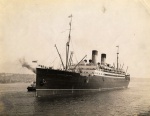 Bateau de croisière «
Bateau de croisière «
Empress of Brit... -
 Bateau de croisière «
Bateau de croisière «
Olympia» sur le...
-
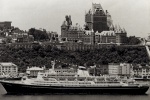 Bateau de croisière S
Bateau de croisière S
S Aleksandr Pus... -
 Bateau de plaisance d
Bateau de plaisance d
evant Québec ve... -
 Bateau-théâtre L'Esc
Bateau-théâtre L'Esc
ale amarré au B... -
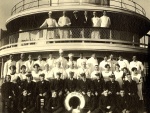 Équipage d'un bateau
Équipage d'un bateau
blanc, 1926
-
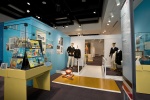 Exposition «Cap sur l
Exposition «Cap sur l
es bateaux blan... -
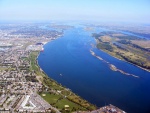 Fleuve Saint-Laurent
Fleuve Saint-Laurent
à vol d'oiseau,... -
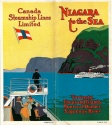 Image promotionnelle
Image promotionnelle
de la Canada St... -
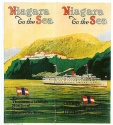 Image promotionnelle
Image promotionnelle
de la Canada St...
-
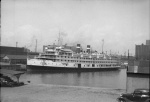 Le «Québec», un des b
Le «Québec», un des b
ateaux blancs a... -
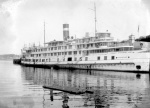 Le bateau «Saguenay»
Le bateau «Saguenay»
de la Canada St... -
 Le bateau à vapeur «I
Le bateau à vapeur «I
roquois» sur le... -
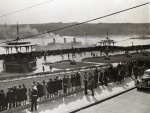 Les navires sur le fl
Les navires sur le fl
euve Saint-Laur...
-
 Passagers du bateau «
Passagers du bateau «
Québec» de la C... -
 Plaisanciers devant K
Plaisanciers devant K
amouraska, août... -
 Tadoussac dans la bai
Tadoussac dans la bai
e -
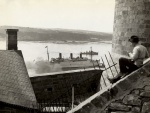 Vue d'un navire sur l
Vue d'un navire sur l
e Saint-Laurent...
-
 Vue du navire «Eskimo
Vue du navire «Eskimo
» de la Canada ... -
 Vue éloignée du batea
Vue éloignée du batea
u «Saguenay» pr... -
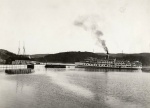 Vue éloignée du navir
Vue éloignée du navir
e de croisière ... -
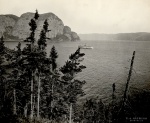 Vue éloignée du prise
Vue éloignée du prise
du Cap Éternit...
Catégories
- Industry & Commerce
- Leisure activities and entertaining practices
- Scenic Areas
- Quebec
- Transportation
Notes
1. In 2008, the Quebec government launched its program "Stratégie de développement durable et de promotion des croisières internationales sur le fleuve Saint-Laurent" (Strategy for sustainable development and promotion of international cruises on the Saint Lawrence River). In the same year, the federal government announced the establisment of its "Support Initiative for International Cruise Development along the St. Lawrence and Saguenay Rivers".
2. Gerald Tulchinsky, "Une entreprise maritime canadienne-française - la Compagnie du Richelieu, 1845-1854", Revue d’histoire de l’Amérique française, 26, 4 (1973), p. 559-582.
3. This major transaction was carried out by the shipbuilder and politician Louis-Adélard Senécal, president of the company since 1882, who in the same year acquired the Compagnie de navigation de Longueuil and the Laprairie company. http://www.biographi.ca/009004-119.01-f.php?&id_nbr=5826
4. Luc Tittley, "Les croisières sur le Saint-Laurent… un peu d’histoire", Teoros, 14, 2 (1995), p. 12-14
5. Michel Lessard, "La vogue des bateaux blancs", Cap-aux-Diamants : la revue d’histoire du Québec, 33 (1993), p. 50-52.
6. Tittley, "Les croisières sur le Saint-Laurent… ".
7. Lessard, "La vogue des bateaux blancs". Philippe Dubé (with Jacques Blouin), Deux cents ans de villégiature dans Charlevoix: l’histoire du pays visité, Québec, Presses de l’Université Laval, 1986.
8. Serge Gagnon, L’échiquier touristique québécois, Québec, Presses de l’Université du Québec, 2003, p. 146-148.
9. Michel Lessard, "L’Hôtel Tadoussac et le Manoir Richelieu: villégiature et culture" Cap-aux-Diamants: la revue d’histoire du Québec, 33 (1993), p. 24-27.
10. Gagnon, L’échiquier touristique québécois, p. 154.
11. The pier was built by the government in London. Gagnon, L’échiquier touristique québécois, p. 146.
12. His nephew Rodolphe Forget succeeded him as president of the company in 1904.
13. This was the site of La Malbaie's first hotel, built thirty years earlier by private citizens. In the early twentieth century, the Manoir Richelieu's clientele included silent-movie stars such as Charlie Chaplin and Mary Pickford, and politicians such as Wilfrid Laurier, prime minister of Canada, and William H. Taft, president of the United States. Serge Gauthier, "La petite histoire d’un grand hôtel", Histoire Québec, 9, 1 (2003), p. 14-17. Tittley, "Les croisières sur le Saint-Laurent…".
14. The Murray Bay Golf Club, located near the Manoir Richelieu at La Malbaie, was founded in 1876 and is the third oldest golf club in North America. The two oldest are also in Quebec: Orléans Golf Club, at Sainte-Pétronille on the Île d'Orléans (1868), and the Royal Montreal Golf Club (1873).
15. Gauthier, "La petite histoire d’un grand hôtel".
16. Lessard, "L’Hôtel Tadoussac et le Manoir Richelieu…".
17. Bowls or lawn bowling, a game which originated in England, is played on a bowling green (boulingrin in French). Played in private clubs, it was at that time the preserve of the elite.
18. Gauthier, "La petite histoire d’un grand hôtel".
19. Lessard, "La vogue des bateaux blancs".
20. Claude Morin, "Exposition au Musée de Charlevoix – Ainsi renaît l’époque des 'bateaux blancs'", Le Devoir, 12 novembre 2011.
21. Nathalie Hamel, "Un musée amérindien à Tadoussac: le projet de William H. Coverdale", Ethnologies, 24, 2 (2002), p. 79-105.
22. Hamel, "Un musée amérindien à Tadoussac…".
Bibliographie
Dagenais, Michèle, "Fuir la ville: villégiature et villégiateurs dans la région de Montréal, 1890-1940", Revue d’histoire de l’Amérique française, 58, 3 (2005), pp. 315-345.
Dubé, Philippe (with Jacques Blouin), Deux cents ans de villégiature dans Charlevoix: l’histoire du pays visité, Québec, Presses de l’Université Laval, 1986.
Gagnon, Serge, L’échiquier touristique québécois, Québec, Presses de l’Université du Québec, 2003.
Gauthier, Serge, "La petite histoire d’un grand hôtel", Histoire Québec, 9, 1 (2003), p. 14-17.
Hamel, Nathalie, "Un musée amérindien à Tadoussac: le projet de William H. Coverdale", Ethnologies, 24, 2 (2002), p. 79-105.
Lessard, Michel, "La vogue des bateaux blancs", Cap-aux-Diamants: la revue d’histoire du Québec, 33 (1993), p. 50-52.
Lessard, Michel, "L’Hôtel Tadoussac et le Manoir Richelieu: villégiature et culture", Cap-aux-Diamants: la revue d’histoire du Québec, 33 (1993), p. 24-27.
Tittley, Luc, "Les croisières sur le Saint-Laurent… un peu d’histoire", Teoros, 14, 2 (1995), p. 12-14.
Tulchinsky, Gerald, "Une entreprise maritime canadienne-française – la Compagnie du Richelieu, 1845-1854", Revue d’histoire de l’Amérique française, 26, 4 (1973), p. 559-582.

